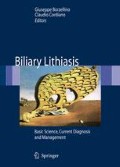Abstract
The most common techniques for the treatment of common bile duct (CBD) stones have been outlined in detail in the preceding four chapters. In this chapter we evaluate the published evidence for these techniques and provide conclusions with clinical validity for practicing physicians. We have summarised these findings with the use of a flow diagram (Fig. 27.1) for quick reference to help guide evidence-and expertise-based management.
Access this chapter
Tax calculation will be finalised at checkout
Purchases are for personal use only
Preview
Unable to display preview. Download preview PDF.
References
Martin DJ, Vernon DR, Toouli J (2006) Surgical versus endoscopic treatment of bile duct stones. Cochrane Database Syst Rev Apr 19:2
Ko CW, Lee SP (2002) Epidemiology and natural history of common bile duct stones and prediction of disease. Review. Gastrointest Endosc 56:S165–S169
Lund J (1960) Surgical indications in cholelithiasis: prophylactic cholecystectomy elucidated on the basis of long-term follow up on 526 nonoperated cases. Ann Surg 151:153–162
Wenckert A, Robertson B (1996) The natural course of gallstone disease: eleven-year review of 781 nonoperated cases. Gastroenterology 50:376–381
Martin IJ, Bailey IS, Rhodes M et al (1998) Towards T-tube free laparoscopic bile duct exploration: a methodologic evolution during 300 consecutive procedures. Ann Surg 228:29–34
Hammett I, Martin IJ, Martin DJ et al (2008) Long term outcomes following laparoscopic bile duct exploration: A consecutive 5 year follow-up of 150 patients. ANZ J Surg (in press)
Courvoisier L (1890) Statististische Beitrage zur Pathologie und Chirurgie der Gallenwege [Statistical article on the pathology and surgery of the biliary system]. Leipzig: Vogel 387:57–58
Vitale GC (2007) Early management of acute gallstone pancreatitis. Ann Surg 245:18–19
Schulman CI, Levi J, Sleeman D et al (2007) Are we training our residents to perform open gall bladder and common bile duct operations? J Surg Res 142:246–249
Sgourakis G, Karaliotas K (2002) Laparoscopic common bile duct exploration and cholecystectomy versus endoscopic stone extraction and laparoscopic cholecystectomy for choledocholithiasis. A prospective randomized study. Minerva Chirurgica 57:467–474
Lella F, Bagnolo F, Rebuffat C et al (1999) E.A.E.S. multicenter prospective randomized trial comparing two-stage vs single-stage management of patients with gallstone disease and ductal calculi. Surg Endosc 13:952–957
Rogers S, Cello JP, Horn JK et al (1999) Randomized controlled clinical trial of laparascopic cholecystectomy plus laparoscopic common bile duct exploration (LC+LCBDE) vs ERCP sphincterotomy plus laparascopic cholecystectomy (ERCP/S+LC) for common bile duct stone disease [abstract]. J Gastroenterol Hepato 14 (Suppl): S110
Nathanson LK, O’Rourke NA, Martin IJ et al (2005). Postoperative ERCP versus laparoscopic choledochotomy for clearance of selected bile duct calculi: a randomized trial. Ann Surg 242:188–192
Rhodes M, Sussman L, Cohen et al (1998) Randomised trial of laparoscopic exploration of common bile duct versus postoperative endoscopic retrograde cholangiography for common bile duct stones. Lancet 351:159–161
Hong DF, Xin Y, Chen DW (2006) Comparison of laparoscopic cholecystectomy combined with intraoperative endoscopic sphincterotomy and laparoscopic exploration of the common bile duct for cholecystocholedocholithiasis. Surg Endosc 20:424–427
Wei Q, Wang JG, Li LB, Li JD (2003) Management of choledo-cholithiasis: comparison between laparoscopic common bile duct exploration and intraoperative endoscopic sphincterotomy. World J Gastroenterol 9:2856–2858
Rabago LR, Vicente C, Soler F et al (2006) Two-stage treatment with preoperative endoscopic retrograde cholangio pancreatography (ERCP) compared with single-stage treatment with intraoperative ERCP for patients with symptomatic cholelithiasis with possible choledocholithiasis. Endoscopy 38:779–786
Lella F, Bagnolo F, Rebuffat C et al (2006) Use of the laparoscopic-endoscopic approach, the socalled “Rendez-vous” technique, in cholecystocholedocholithiasis: a valid method in cases with patient-related risk factors for post-ERCP pancreatitis. Surg Endosc 20:419–423
Morino M, Baracchi F, Miglietta C et al (2006) Preoperative endoscopic sphincterotomy versus laparoendoscopic Rendez-vous in patients with gallbladder and bile duct stones. Ann Surg 244:889–893
Chang L, Lo S, Stabile BE et al (2000) Preoperative versus postoperative endoscopic retrograde cholangiopancreatography in mild to moderate gallstone pancreatitis: a prospective randomized trial. Ann Surg 231:82–87
Tricarico A, Cione G, Sczio M et al (2002) Endolaparoscopic Rendez-vous treatment: a satisfying therapeutic choice for cholecysterctocholedocholithiasis. Surg Endosc 16:585–588
Martin CJ, Cox MR, Vaccaro L (2002) Laparoscopic transcystic bile duct stenting in the management of common bile duct stones. ANZ J Surg 72:258–264
Rojas-Ortega S, Arizpe-Bravo D, Marin Lopez ER et al (2003) Transcystic common bile duct exploration in the management of patients with choledocholithiasis. J Gastrointest Surg 7:492–496
Topal B, Aerts R, Penninckx F (2007) Laparoscopic common bile duct stone clearance with flexible choledochoscopy. Surg Endosc 21:2317–2321
Bergman JG, Rauws EA, Fockens P et al (1997) Randomised trial of endoscopic balloon dilation versus endoscopic sphincterotomy for removal of bile duct stones. Lancet 349:1124–1129
Freeman ML, Nelson DB, Sherman S et al (1996) Complications of endoscopic biliary sphincterotomy. N Engl J Med 335:909–918
Hammarstrom LE, Holmin T, Stridbeck H et al (1995) Long-term follow-up of a prospective randomized study of endoscopic versus surgical treatment of bile duct calculi in patients with gallbladder in situ. Br J Surg 82:1516–1521
Suc B, Escat J, Cherqui et al (1998) Surgery endoscopy as primary treatment in symptomatic patients with suspected common bile duct stones: a multicenter randomized trial. French Associations for Surgical Research. Arch Surg 133:702–708
Targarona EM, Perez Ayuso RM, Bordas JM et al (1996) Randomised trial of endoscopic sphincterotomy with gall bladder left in situ versus open surgery for common bile duct calculi in high risk patients. Lancet 347:926–929
Pereira-Lima JC, Jakobs R, Winter WH et al (1998) Long-term results (7 to 10 years) of endoscopic papillotomy for choledocholithiasis. Multivariate analysis of prognostic factors for the recurrence of biliary symptoms. Gastrointest Endosc 48:457–464
Chen B, Hu SY, Wang L et al (2007) Reoperation of biliary tract by laparoscopy: a consecutive series of 26 cases. Acta Chir Belg. 107:292–296
Author information
Authors and Affiliations
Rights and permissions
Copyright information
© 2008 Springer-Verlag Italia
About this chapter
Cite this chapter
Martin, D., Martin, I. (2008). Flow Chart for the Treatment of CBDS and Critical Comparison of Techniques. In: Biliary Lithiasis. Springer, Milano. https://doi.org/10.1007/978-88-470-0763-5_27
Download citation
DOI: https://doi.org/10.1007/978-88-470-0763-5_27
Publisher Name: Springer, Milano
Print ISBN: 978-88-470-0762-8
Online ISBN: 978-88-470-0763-5
eBook Packages: MedicineMedicine (R0)

